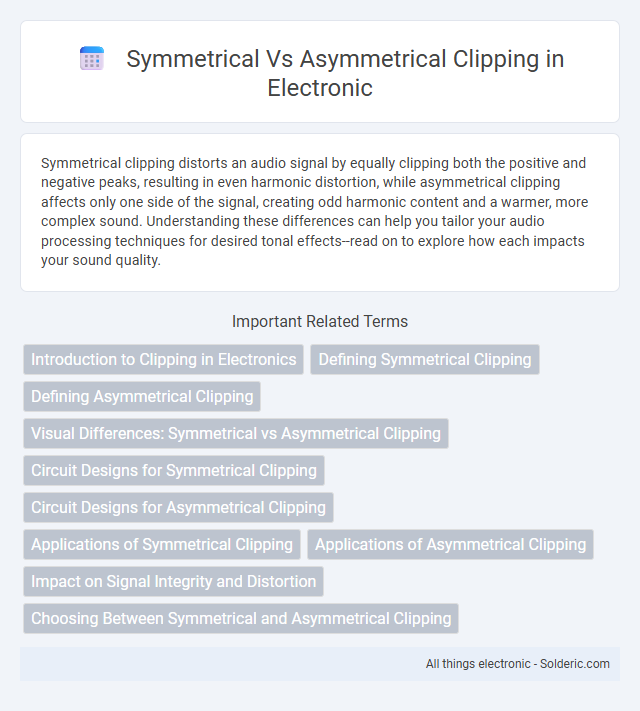Symmetrical clipping distorts an audio signal by equally clipping both the positive and negative peaks, resulting in even harmonic distortion, while asymmetrical clipping affects only one side of the signal, creating odd harmonic content and a warmer, more complex sound. Understanding these differences can help you tailor your audio processing techniques for desired tonal effects--read on to explore how each impacts your sound quality.
Comparison Table
| Feature | Symmetrical Clipping | Asymmetrical Clipping |
|---|---|---|
| Definition | Clipping occurs equally on positive and negative signal peaks. | Clipping occurs unevenly, usually on either positive or negative peaks only. |
| Signal Distortion | Produces more balanced harmonic distortion. | Generates more asymmetric harmonic distortion, often harsher. |
| Waveform Shape | Symmetrical flattening of waveform peaks. | Unequal flattening, creating waveform asymmetry. |
| Typical Application | Audio signal processing for subtle effects. | Distortion effects needing strong harmonic emphasis. |
| Impact on Sound | Maintains tonal balance, warmer sound. | Can produce more aggressive or "edgy" tones. |
Introduction to Clipping in Electronics
Clipping in electronics occurs when an amplifier is overdriven and attempts to deliver an output voltage beyond its maximum capability, resulting in distortion of the signal waveform. Symmetrical clipping occurs when both the positive and negative peaks of the signal are clipped evenly, maintaining waveform balance, while asymmetrical clipping affects only one polarity, causing uneven distortion. Understanding the differences helps you manage signal integrity and prevent unwanted audio or signal degradation in electronic circuits.
Defining Symmetrical Clipping
Symmetrical clipping occurs when an audio signal is clipped equally on both the positive and negative peaks, resulting in uniform distortion that maintains waveform balance. This type of clipping affects both halves of the waveform symmetrically, preserving harmonic content but increasing harmonic distortion. In contrast, asymmetrical clipping clips only one half of the waveform, often producing more complex harmonic overtones and a different tonal character.
Defining Asymmetrical Clipping
Asymmetrical clipping occurs when an audio signal is clipped unevenly, causing distortion that affects the positive and negative halves of the waveform differently. This type of clipping introduces harmonic distortion primarily consisting of even-order harmonics, which can result in a warmer, sometimes harsher sound compared to symmetrical clipping. It is commonly used in guitar effects and tube amplifier simulations to create unique tonal characteristics.
Visual Differences: Symmetrical vs Asymmetrical Clipping
Symmetrical clipping results in the waveform being evenly cut off on both the positive and negative peaks, creating a balanced distortion that appears uniform visually. Asymmetrical clipping, however, clips the waveform unevenly, affecting one side more than the other, which produces a distorted waveform with an unbalanced shape and often introduces odd harmonics. Your choice between these clipping types directly influences the visual symmetry of the audio signal's waveform and the harmonic content of the resulting sound.
Circuit Designs for Symmetrical Clipping
Circuit designs for symmetrical clipping typically involve pushing an audio signal equally beyond positive and negative thresholds, often using paired diodes or transistor arrangements to limit amplitude symmetrically. This approach preserves the waveform's balance, minimizing harmonic distortion and generating even-order harmonics for a smoother, more musical overdrive effect. Your audio equipment benefits from these circuits by achieving consistent clipping characteristics that maintain tonal integrity.
Circuit Designs for Asymmetrical Clipping
Circuit designs for asymmetrical clipping typically involve diodes or transistors configured to clip the waveform on only one side, either positive or negative, creating a distorted output with pronounced harmonic content. Common implementations use diode pairs with different threshold voltages or biasing to achieve the asymmetry, such as the classic half-wave rectifier or biased diode clipping circuits. These circuits are often employed in audio processing to add warmth or rawness to guitar effects, emphasizing odd harmonic generation compared to symmetrical clipping's even harmonic emphasis.
Applications of Symmetrical Clipping
Symmetrical clipping is widely used in audio signal processing to maintain harmonic distortion that is musically pleasing, making it ideal for guitar amplifiers and distortion pedals. It preserves signal symmetry by clipping both positive and negative waveform peaks equally, resulting in a more balanced and warm sound. This technique is favored in applications requiring controlled distortion without introducing harsh odd-order harmonics.
Applications of Asymmetrical Clipping
Asymmetrical clipping is widely used in audio signal processing to create distinctive tonal effects and harmonic distortion in electric guitar amplifiers and synthesizers. Its application in dynamic range compression helps achieve unique sound textures by selectively altering waveform peaks, enhancing the musical expressiveness. Sound designers exploit asymmetrical clipping to produce richer, more complex harmonics, making it a preferred choice in creative audio production and electronic music.
Impact on Signal Integrity and Distortion
Symmetrical clipping preserves signal integrity better by evenly limiting both positive and negative peaks, reducing harmonic distortion and maintaining waveform symmetry. Asymmetrical clipping introduces uneven signal clipping, causing increased harmonic distortion and intermodulation products that degrade audio quality and clarity. Understanding these differences helps you choose the appropriate clipping method for minimizing distortion in audio processing or communication systems.
Choosing Between Symmetrical and Asymmetrical Clipping
Choosing between symmetrical and asymmetrical clipping depends on the desired distortion characteristics in audio processing or signal shaping. Symmetrical clipping limits the positive and negative signal peaks equally, producing even-order harmonics and a more balanced, natural distortion ideal for guitar effects or mild overdrive. Asymmetrical clipping, by contrast, distorts the signal unevenly, generating odd-order harmonics that create a harsher, more aggressive tone suited for heavier distortion and unique sound design.
symmetrical vs asymmetrical clipping Infographic

 solderic.com
solderic.com